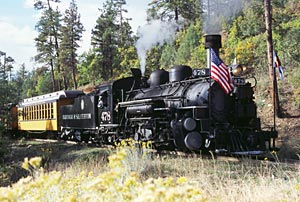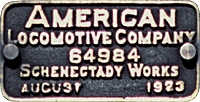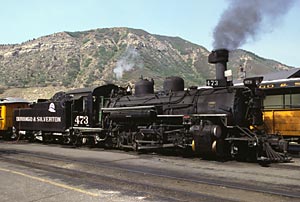Denver & Rio Grande Western K-28 Mikado
|
|

D&RGW K-28 Mikado #478 in operation on the Durango & Silverton Narrow Gauge Railroad.
|
|
|
Twenty years after purchasing its last new class of narrow gauge locomotives, the K-27 in 1903, the Rio Grande implemented a system-wide track modernization allowing the use of heavier engines and acquired ten new outside frame Mikado in 1923. Equipped with superheating, a little heavier and marginally more powerful than the K-27, these locomotives were ordered this time from the American Locomotive Company (Alco), they formed the class K-28 (briefly designated class 140 before 1924) and were numbered from 470 to 479. Because of their (relatively) large 44" drivers allowing them to reach 40 mph, they were specialized in passenger service, which earned them the nickname Sport Models. The K-28 were used to replace the antiquated 4-6-0 T-12 on passenger trains thoughout the D&RGW narrow gauge system and particularly on the Marshall Pass and Cumbres Pass lines. In 1936-37, the K-28 were equipped with steam heating and air signal system to pull the modernized passenger cars used on the Shavano (Salida - Gunnison) and San Juan (Alamosa - Durango) trains, except for #474 which was exclusively used on freight trains around Gunnison. The K-28 were assigned to these two trains until they were discontinued in 1940 and 1951 respectively. A K-28 was also used on the Chili line mixed train (Antonito - Santa Fe) until the line abandonment in 1941.

The front end of K-28 #473 featuring the cross compound air pump typical of this class.
|
|
|
|
During World War II in 1942, the US Army demanded to requisition all 10 D&RGW K-28 for use on the White Pass & Yukon Railroad (WP&YR), a narrow gauge railroad linking southeast Alaska and Yukon Territory in Canada. The army took over the operation of the WP&YR itself, as it was a vital feeder to supply construction equipment to build the Alaska Highway, a route of strategic importance for the defense of Alaska. The Rio Grande managed to keep three K-28, but the other seven (#470, 471, 472, 474, 475, 477 and 479) were transferred to Alaska and renumbered USA 250 to 256 (but they would never be included in the WP&YR roster). They were subjected to a hard service with little maintenance, were put through a lot of strain by the very harsh winters of 1943 and 1944 and were worn out by the end of the war. They were taken back to Seattle, Washington in 1945, where they were scrapped on location in 1946, except for #472, brought to Seattle for repairs in 1944, and then transferred to Ogden, Utah where it was eventually scrapped as well in 1946. The three K-28 remaining on the Rio Grande (#473, 476 and 478) continued to be used on the San Juan during and after the war until the train was discontinued. Later during the fifties, they replaced the retiring K-27 on the Durango - Silverton branch. They were at first used on the single weekly mixed train, and then became the emblematic locomotives of the Silverton when tourism business developped and the number of trains increased in the sixties and seventies. In 1981, the D&RGW sold the three K-28 to the Durango & Silverton Narrow Gauge Railroad, the new operator of the line.

|
K-28 specifications (#470 to 479)
|
Builder (year)
|
Alco (1923)
|
|
Wheel arrangement
|
2-8-2 (Mikado)
|
|
Cylinders (diameter x stroke)
|
2 external (18" x 22")
|
|
Boiler pressure
|
200 psi
|
|
Drivers diameter
|
44"
|
|
Total weight (loaded tender)
|
127.2 t (49.3 t)
|
|
Maximum tractive effort
|
27,500 lbs
|
|
|
-
Surviving D&RGW K-28 today
Only three K-28 are still in existence today, number 473, 476 and 478. All three are on the Durango & Silverton Narrow Gauge Railroad.

K-28 #473 at the station in Durango.
|
|

#478 idle in Silverton.
|
|






